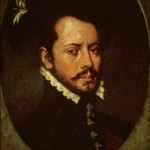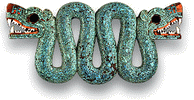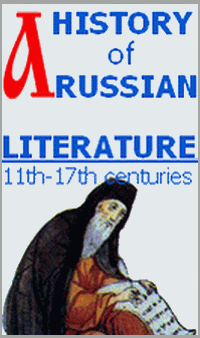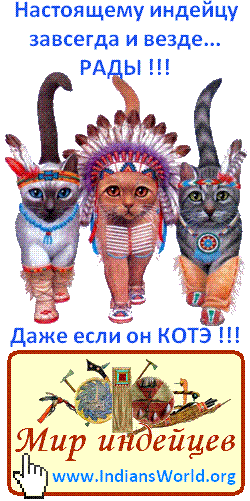Hernan Cortes and the Conquest of the Aztec empire (Mexico) by Spaniards
Category: Aztec Cortes was born in the city of Medillin, on the banks of the Guadiana River, in the province of Estramadura, in the country of Spain. This was in 1485, in the last years of the Middle Ages. Estramadura was a poor and unforgiving place that was void of opportunities. Its summers brought blinding heat and its winters brought bitter cold. The soil was thin and poor and only olive trees and cork oaks could grow. It was the type of place that would inspire people to go on risky ventures in the hopes of finding wealth. Many of the great conquistadors would end up coming from this province including the Pizzaros, Balboa, and Hernando de Soto.
Cortes was born in the city of Medillin, on the banks of the Guadiana River, in the province of Estramadura, in the country of Spain. This was in 1485, in the last years of the Middle Ages. Estramadura was a poor and unforgiving place that was void of opportunities. Its summers brought blinding heat and its winters brought bitter cold. The soil was thin and poor and only olive trees and cork oaks could grow. It was the type of place that would inspire people to go on risky ventures in the hopes of finding wealth. Many of the great conquistadors would end up coming from this province including the Pizzaros, Balboa, and Hernando de Soto.
Cortes was from an honorable family with some wealth. Little is known about his earliest years. However, by age fourteen he was sent to the city of Salamanca to study grammar and Latin in the hopes that he would have a career in law. In his late teens Cortes entered the Spanish army in hopes of finding his fortune. Before long he decided that the opportunities were in the New World. He caught his first ship to the New World when he was only nineteen. Then, when Diego Velazquez was sent to conquer Cuba in 1511, Cortes came along as the treasurer. Velazquez rewarded Cortes when he became governor of Cuba by giving him a grant of Indians. Subsequently, Cortes settled in Santiago de Baracoa and raised cattle. At the same time his Indians mined enough gold to set him up as a merchant in the trading business. Cortes held various positions in the local government and was a respected member of the community.
Valesquez was not very happy when Cortes began assembling men and supplies for his fabled trip to the Yucatan Peninsula. The expenses mounted quickly and Cortes took on a huge amount of debt, but nothing could stop him. On February 18, 1519, he lifted anchor with 550 men… The men were divided into eleven companies and placed on eleven ships. None of the ships were very large. Also, he brought along sixteen expensive horses and one cannon. Cortes and his men landed on the island of Cozumel where they made contact with a white man who had been shipwrecked. His name was Jeronimo de Aguilar and he provided them with badly needed information. He was very knowledgeable about the customs and native languages. All of this information would help Cortes in the months to come. Then, in Tabasco they were attacked and lost several men. However, the Indians suffered hundreds of casualties and surrendered. They provided information about the riches that could be found if they continued traveling west. In addition they gave Cortes a gift of twenty maidens. One of these maidens spoke Nahuatl and Mayan dialects. The Spaniards baptized her with the name of. Dona Marina. Later she would be called Malinche (the name the Aztecs called Cortes) by the Mexican people who considered her part in the Spanish Conquest as treasonous.
As Cortes and his men traveled westward they were met by some emissaries who represented the great Aztec ruler Montezuma. Montezuma sent them gifts of gold and gems, but told them not to come any farther because the journey was too difficult. However, all the gifts did was peak Cortes’s interests. He was now more determined than ever to find the kingdom that was rich in gold. Next, Cortes founded the city of La Villa Rica de Vera Cruz which would eventually become the city of Veracruz. Then, because many of his men were soldiers of fortune he was having troubles controlling their mutinous behavior so he sank all eleven ships.
Next, Cortes began marching toward the Aztec capital of Tenochtitlan. The first group of lndians he and his men encountered were the Tlaxcalans who were bitter enemies of the Aztecs. Before long, a battle erupted and the Spanish guns and horses were no match for the Taxcalan warriors who suffered major loses. After the battle Cortes successfully convinced the Tlaxcalans to join him. At this time, Montezuma again sent more emissaries who warned Cortes not to go to Tenochtitlan. A short time later the Spaniards arrived in the town of Cholula where they were fed and housed. There Cortes and Dona Marina began to hear rumors that they were going to be attacked. Cortes decided not to wait until he was attacked, instead he alerted his men who cut down innocent people in droves with their guns. By the time the Spaniards were done the city had been burned to the ground and over six thousand Cholulans lay dead in the streets.
When the Spaniards first caught glimpse of Tenochtiltlan they couldn’t believe that what they were seeing. Tenochtitlan sat on an island in the middle of Lake Texcoco. The city was so beautiful and the pyramids and temples just seemed to rise out of the water. Thousands of natives gathered along the roadways to get a view of the bearded strangers and their horses. Then as they continued down the main causeway to the Aztec capital they were greeted by Montezuma who was being carried on a luxurious litter covered in quetzal feathers. Montezuma and Cortes exchanged necklaces and they were offered accommodations in Tenochtitlan. In Tenochtitlan they were housed in the old palace of Montezuma’s father Axayacatl. However, almost as soon as they arrived they found themselves completely surrounded by hundreds of Montezuma’s warriors. Before long, Montezuma look Cortes on a lour of the city. First, he viewed the enormous outdoor market in Plaza of Tlaltelolco. The Spaniards were amazed at the amount of products for sale as well as the enormous orderly crowds. Then, they were taken to the Temple of Huichilobos where they witnessed human sacrifices. Cortes was appalled at what he saw. He immediately tried to tell Montezuma that he should abandon his religion and convert to Christianity. After an extensive tour of the temples they returned to their quarters. The Spaniards had been told that there was treasure in the building where they were staying, but they had no idea where it was hidden. After a few days Cortes asked permission to build an alter in the building so that the Spaniards had a place to pray. Alonzo Yates, who was a carpenter was looking for a convenient place to put the alter when he noticed that a doorway had been closed up and plastered over. Once the doorway was secretly opened Cortes and his men found more riches than they ever imagined. Soon afterward, four of Cortes captains took him aside and warned him that things were quickly changing and that they were in fear of their lives. Then, word came that some of Cortes’s men at Villa Rica had been attacked and killed.
Cortes and his men went to Montezuma’s palace and confronted Montezuma about the killings. Montezuma denied having any involvement, but Cortes seized the moment and kidnaped Montezuma. Montezuma was treated with respect. He was allowed to keep his wife, servants, and some of his mistresses. In addition, he was allowed to go hunting. Cortes in the meantime demanded that Montezuma continue to collect tribute (taxes) from his people. They did so reluctantly until they became apprehensive. Montezuma tried to convince his people that he was still their ruler, but they began to not believe him. Then, troubles developed with Governor Velazquez who believed that what Cortes was doing may be treasonous. He no longer trusted Cortes so he assembled a large force and sent them to arrest Cortes. As soon as Cortes heard about his impending arrest he and men went to Veracruz to meet Velazquez’s troops. Cortes attacked them in the middle of the night and quickly took control of the situation.
While he was away he left Pedro de Alvarado and 140 of his men in charge of Montezuma and Tenochtitlan. Then, during an Aztec celebration to their war god the Aztecs began drinking and dancing. During the celebration Alvarado became nervous and closed off the four exits and attacked the largely unarmed Aztecs killing hundreds. When Cortes returned to the city he found it totally quiet. As the Spaniards entered the city they were attacked and found themselves fearing for their lives. Cortes asked Montezuma to get on top of a roof and tell the Aztecs that they would leave the city. However, as Montezuma spoke he was struck with stones thrown by the Aztecs who no longer believed in him. He died three days later. As the story goes he was struck by a stone in the temple and died three days later. However, many believe that he was killed by Cortes. Cortes continued to beg the Aztecs for a truce, but they would have nothing to do with it. Quickly, the Spaniards divided up the gold. Cortes himself loaded down a group of Tlaxcalans with gold and gemstones for himself. Next, they attempted to flee the city by way of a two mile causeway that crossed Lake Texcoco. They left the city at midnight under a thick fog and light rain. Thousands of Indians attacked and it was every man for himself. Cortes and much of his gold escaped, but over 450 of his men died as well as 4,000 Aztecs.
 Cortes and the Aztecs were now at war and there would be no negotiations for a truce. They appointed a new emperor, but he was killed by smallpox. Smallpox spread rapidly throughout the Aztec empire with devastating consequences. Next, the Aztecs appointed a nephew of Montezuma emperor. His name was Cuauhtemoc. At the same time a ship arrived carrying badly needed supplies. Cortes used the gold that he had stolen to purchase new weapons and supplies. He decided that he would make one final assault against the Aztecs. The Spaniards and the Tlaxcalans constructed a series of thirteen launches to help him assault the island kingdom. The boats were fitted with sails, oars, and a cannon. This time Cortes attacked with 900 Spaniards, 80 horses. They used crossbows, guns, cannons, and swords. Most wore protective armor. In addition, he used the help of tens of thousands of auxiliary Indian forces. Fighting continued for weeks. One of the first things Cortes did was cut off the food and water supplies. Starving, the Aztecs gave up on August 13, 1521. Subsequently, Cortes and his men tortured Cuauhtemoc and his lords hoping that they would give up the location of other riches, but none were ever found. King Charles V rewarded Cortes with twenty-two encomiendas (land grants) and twenty-three thousand Indian slaves. Also, he was given the title of Marques del Valle de Oaxaca.
Cortes and the Aztecs were now at war and there would be no negotiations for a truce. They appointed a new emperor, but he was killed by smallpox. Smallpox spread rapidly throughout the Aztec empire with devastating consequences. Next, the Aztecs appointed a nephew of Montezuma emperor. His name was Cuauhtemoc. At the same time a ship arrived carrying badly needed supplies. Cortes used the gold that he had stolen to purchase new weapons and supplies. He decided that he would make one final assault against the Aztecs. The Spaniards and the Tlaxcalans constructed a series of thirteen launches to help him assault the island kingdom. The boats were fitted with sails, oars, and a cannon. This time Cortes attacked with 900 Spaniards, 80 horses. They used crossbows, guns, cannons, and swords. Most wore protective armor. In addition, he used the help of tens of thousands of auxiliary Indian forces. Fighting continued for weeks. One of the first things Cortes did was cut off the food and water supplies. Starving, the Aztecs gave up on August 13, 1521. Subsequently, Cortes and his men tortured Cuauhtemoc and his lords hoping that they would give up the location of other riches, but none were ever found. King Charles V rewarded Cortes with twenty-two encomiendas (land grants) and twenty-three thousand Indian slaves. Also, he was given the title of Marques del Valle de Oaxaca.


